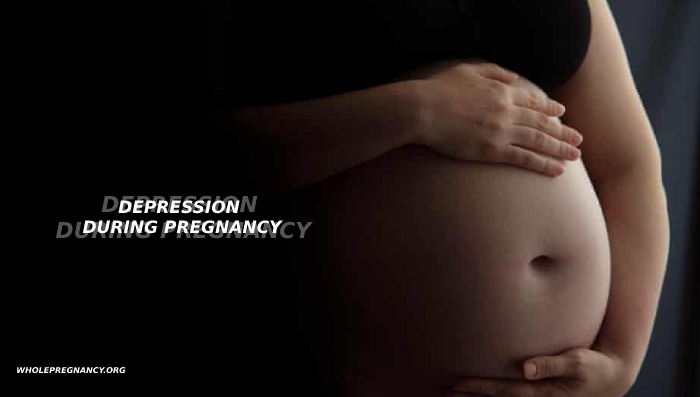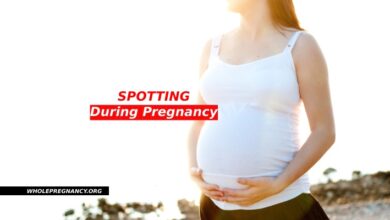Depression During Pregnancy

Perinatal depression refers to depression during pregnancy, or within the first year of having a baby. You are not the only pregnant woman with depression, as depression during pregnancy is a bit popular and it is due to many reasons and factors. Continue reading this article to know better how to deal with it.
What is Depression?
Depression, also known as major depression or clinical depression, is a medical condition that can cause sadness and loss of interest in activities you enjoy. It can impact your mood, thoughts and actions and interfere with your daily activities. To get better, it needs to be treated. Perinatal depression refers to depression that occurs during pregnancy, or within the first year of having a baby. It is one of the most common medical complications during pregnancy.
Depression can affect up to one in seven women (about 15%). It also includes postpartum Depression (also known as PPD), which refers to depression that occurs after pregnancy. Depression isn’t your fault. You can feel better with treatment. Perinatal depression that is not treated can lead to serious health problems for both you and your baby. Tell your health care provider immediately if you feel depressed.
Before worrying about your depression during pregnancy
- Depression isn’t your fault. It is a medical condition that requires treatment. Tell your doctor if you suspect you may have depression.
- Depression risk factors include depression in the past, a family history of it, and stressful situations in your life.
- Some counseling methods can help you avoid depression. Talk to your doctor if you are at high risk of depression.
- Premature birth can be a problem if you don’t treat depression properly. Tell your doctor if you feel depressed.
- Talk to your doctor if you are taking antidepressants during pregnancy..
What are the symptoms and signs of depression?
Major depression can be more than feeling sad for a few days. If you experience depression symptoms or signs that last more than two weeks, then you may be diagnosed with major depression. A condition is something that someone can see about you. For example, a rash, or a cough. You feel symptoms, which are things that you don’t know about yourself.
Depression Symptoms and Signs Include:
Mood swings
- Feeling depressed, hopeless, or overwhelmed
- Feeling restless, or moody.
- Crying a lot.
- Feeling guilty or worthless.
- Think about suicide or death (killing oneself).
The changes in your daily life
- Eat more or less than usual
- Trouble remembering, concentrating, or making decisions
- Inability to sleep, or too much sleeping
- Resigning from family and friends
- You lose interest in the things you love to do
Modifications to your body
- Feeling tired and depleted of energy all the time
- Headaches, stomach problems, or other pains that persist?
- Digestive Disorders.
Call your doctor if you notice any of these symptoms or signs while pregnant. Your provider and you can do many things to make you feel better.
Are you and your baby susceptible to depression during pregnancy?
Yes, Depression during pregnancy can have some side effects:
- You don’t take care of yourself. If your depression is not treated, you might not be able to eat healthy food or gain enough weight during pregnancy. It is possible to skip prenatal care or ignore instructions from your healthcare provider.
- Smoking, drinking alcohol or using harmful drugs.
- Having PPD after pregnancy. PPD can make it difficult for you to bond with your baby and care for him/her.
- Suicide is the act of killing yourself, thinking about suicide, or contemplating harming your baby. These are uncommon.
Your baby’s chance of developing depression during pregnancy is increased by:
- Premature Birth, this refers to birth that occurs too soon, prior to 37 weeks of pregnancy.
- SGA is short for small gestational age. This refers to a baby who is smaller than he should be before birth.
- Low Birthweight (also known as LBW). This refers to a baby born with a birth weight of less than 5 pounds and 8 ounces.
- Babies born to mothers who didn’t suffer from depression during pregnancy are more likely to be irritable, less active and less attentive than those born to them.
- Later in life, learning, behavior and development issues and mental health conditions are more common
Difficulties in Preparing for The Arrival of Your Baby
It can be difficult to prepare for your baby’s arrival and take care of your baby afterwards if you are suffering from depression during pregnancy. It is important to get treatment for depression as soon as you can. If depression remains untreated,
- It may be difficult to find the right items, such as a crib, car seat or medical supplies to keep your baby safe.
- You may find it difficult to breastfeed your baby for long periods of time. It may be difficult for both you and your baby to adjust to breastfeeding. Breastmilk is the best for baby’s first year.
- You may not be able to provide the medical care your baby needs. If your baby is sick, depression can make it difficult for you to care for her. It’s possible that you don’t see any health issues in your baby. You may find it difficult to provide regular health-baby care such as vaccinations. Vaccinations can help protect your baby against harmful infections.
You can feel better and be ready for the birth of your baby if you seek treatment early for depression. Talk to your doctor if you feel depressed.
What Causes Depression During Pregnancy?
We aren’t sure. It could be a combination, such as changing brain chemicals or hormones. Hormones can be chemicals that are made by the body. Certain hormones may affect parts of the brain that regulate emotions and mood.
Genes can also be responsible for depression. Genes are a part of your cells that stores instructions about how your body works and grows. The genes are passed from one generation to the next. Depression is more common among people whose relatives have suffered from depression. This is known as a family history.
Are You at Risk of Depression?
Certain factors make you more susceptible to depression than others. These are known as risk factors. A risk factor does not guarantee that you will have depression. It may increase your chance of getting depressed. Talk to your doctor about how you can reduce your risk.
Prenatal care checks are where your health care provider screens you for depression. Your provider will ask you questions about your mood, risk factors and feelings. Your provider will help you get treatment if you are diagnosed with depression or at high risk.
Risk factors for depression during pregnancy include:
-
- Have you ever suffered from major depression or other mental health conditions in the past. You have a family history depressive disorder or mental illness. If someone in your family has the condition, it is called “family history”. Even if you feel better after treatment, pregnancy can worsen or cause depression to return.
- You have been sexually or physically abused. You have issues with your partner, such as domestic violence (also known as IPV or intimate partner violence).
- Unplanned pregnancy or unintended. You could be single or pregnant as an adolescent.
- Separation from your partner, death of a family member, or illness that has a negative impact on your life can cause you alot of stress. You may be unemployed, have low income, or receive little or no support from your family and friends.
- Diabetes is a condition. Preexisting Diabetes, also known as pregestational diabetics, can be diagnosed. This refers to diabetes that you had before becoming pregnant. It could also be gestational diabetic. This type of diabetes is common in women who are pregnant.
- There are complications in pregnancy. These include multiples, birth defect, and pregnancy death. Multiples refers to when you are pregnant with more than one child. Birth defects are conditions that can be present at birth. They can cause a change in the function or shape of one or more body parts. Birth defects can affect your overall health, the development of the body and the way it works. When your baby dies during pregnancy, it is called pregnancy loss.
- You smoke, drink alcohol, or use harmful drugs.
Prevent Depression During Pregnancy?
According to the U.S. Preventive Services Task Force, certain types of counseling (also known as therapy) can help prevent perinatal depression in women at higher risk. Counseling is when you share your feelings with a counselor, therapist, or other professional. They can help you to understand your feelings and solve your problems. The Task Force recommends counseling women with one or multiple of these risk factors.
- Current symptoms and signs of depression
- An underlying mental condition such as depression or another mental illness.
- As a teenager, being pregnant or as a single mother
- Low income and stressful life situations
- Being a victim to IPV
Two types of counseling are recommended by the Task Force to prevent depression in women at higher risk for developing it.
Cognitive Behavioral Therapy
Also known as CBT. CBT is a way to manage your negative thoughts and change the way you think. You may use CBT with a therapist, who will help you identify and set goals.
Interpersonal Therapy
also known as IPT is also called IPT. IPT is a way to identify and address problems and situations in your life. This includes relationships with family members, friends, neighbors, medical conditions, loss, or grief. IPT can be done in a variety of ways, including role-playing with therapists, answering open-ended questions (not just yes/no questions), and looking at your decisions and communication with others.
Your provider may be able to help you with IPT and CBT if you are at higher risk of depression. Talk to your provider about your life, pregnancy, and feelings. Your provider will help you find counselors.
How to Treat Depression During Pregnancy?
A team of providers can help you with your depression during pregnancy. These providers can collaborate to ensure that you and your baby receive the best possible care. These providers could be:
- Your prenatal care provider. This provider provides medical care during pregnancy.
- This is your primary care provider. This is your primary care provider and provides you with general medical care.
- A mental health provider. A psychiatrist, psychologist or social worker may be this person.
- The health care provider for your baby
There are many ways to treat depression. Your providers might decide to combine several treatments rather than just one. You may also consider:
- Counseling such as IPT and CBT
- Support groups. These groups are made up of people who come together, or meet online, to share their thoughts and feelings on certain topics. Ask your counselor or provider to help you locate a support group.
- Medicine. Antidepressants are often used to treat depression. These medicines require a prescription from your doctor. One medicine may be used, or you could take a combination of medications. Your provider may not allow you to stop or start taking PPD medication.
- Electroconvulsive therapy (also known as ECT) is a form of electroconvulsive therapy. This treatment involves the passing of an electric current through the brain. This treatment can be used during pregnancy. If severe depression is present, providers may recommend ECT.
What Are The Risks of Taking Antidepressants During Pregnancy?
Pregnancy with antidepressants can increase the risk of birth defects or other health problems. The risk of birth defects and other health problems is usually low in most cases. But if you stop taking an antidepressant during pregnancy, your depression may come back. Your provider should approve you stopping or starting any medication during pregnancy.
Your prenatal care provider, as well as your mental health provider, can all work together to determine the best treatment for you with antidepressants. You should learn as much information as possible about the options available to you so that you can make the right decision for your baby. Talk to your prenatal and/or mental health providers if you are taking antidepressants and plan to become pregnant.
Types of Antidepressants
There are many types of antidepressants. While most antidepressants affect neurotransmitters (chemicals in the brain), each one does something different. Each has its risks and benefits, as well as potential side effects during pregnancy. These antidepressants may be used during pregnancy:
- Serotonin reuptake inhibits (also known as SSRIs) are the most prescribed antidepressant medications. SSRIs may be used during pregnancy, including citalopram (Celexa) and fluoxetine (Prozac)
- Norepinephrine reuptake and serotonin reuptake inhibits (also known SNRIs), such as duloxetine(Cymbalta, and venlafaxine Effexor XR).
- Tricyclic antidepressants (also known as TCAs), such as nortriptyline, Pamelor
- Bupropion Wellbutrin.
If the SSRI paroxetine is given to a pregnant woman in the first trimester, it may cause heart defects. Talk to your doctor immediately if you are pregnant or plan to become pregnant while taking paroxetine. Research suggests that certain antidepressants may lead to miscarriage and low birthweight. It could also cause premature birth, low birthweight, or birth defects (including cardiac defects).
According to the Centers for Disease Control and Prevention (CDC), birth defects are more common in women who use SSRIs paroxetine and fluoxetine. Other SSRIs like sertraline don’t cause birth defect. Research suggests that certain antidepressants can cause babies to become irritable and have trouble eating. More research has not confirmed these claims, so it isn’t possible to know if antidepressants cause these problems. Further research is required.




